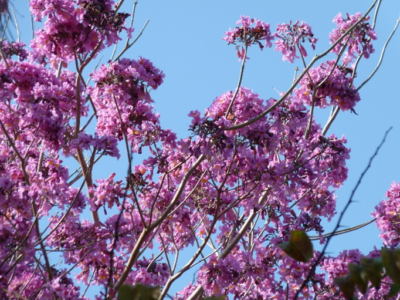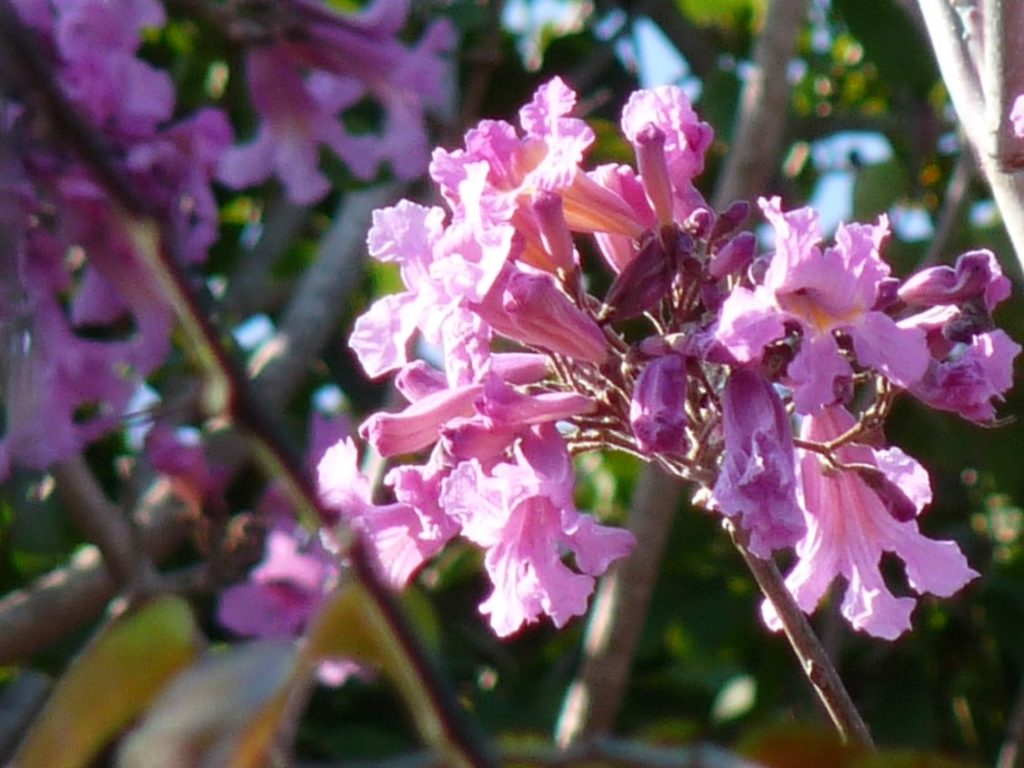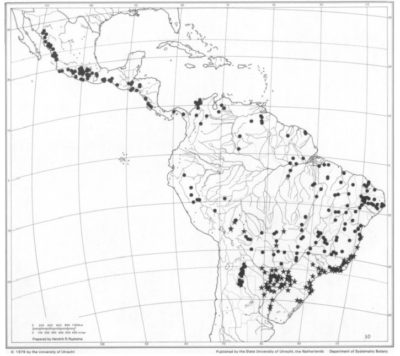
Flowers of the pink trumpet tree at Selby Gardens’ Downtown Sarasota campus (Photo by Bruce K. Holst)
Written by Shawn McCourt, Ph.D., Plant Records Keeper
Just beside the path south of the Children’s Rainforest Garden at Marie Selby Botanical Gardens’ downtown campus is a beautiful, deciduous shade tree that heralds every spring with thousands of 2-3” pink-lavender, trumpet-shaped flowers set against the deep cerulean skies of February and March. It’s currently labeled as Handroanthus impetignosus, a large, commercially important timber tree; however, it has recently come to light that it may be a similar and somewhat smaller species, Handroanthus heptaphyllus, which has a more restricted natural range than the former. H. impetignosus has one of the longest geographic ranges of any tree species- it extends from northern Mexico to northern Argentina, a distance of at least 5,000 miles (8,000 km) as the plane flies. In contrast, H. heptaphyllus is found only in South America (see map), in the mata atlantica of coastal Brazil, from Bahia to Rio Grande do Sul, in the Paraná drainage of Paraguay and northeastern Argentina, and sparsely across the moist regions of the Chaco west to Bolivia at elevations below 1000 meters (Gentry 1992). It is the national tree of Paraguay, where it blooms in September (spring in the southern hemisphere). Both species have palmate leaves with 5-7 leaflets, but those of H. heptaphylla are serrate and to about 10 cm long while those of H. impetignosus are usually entire and are up to 20 cm long. The former also tends to be a smaller tree (to 15 m) and has deeply furrowed bark, while the latter is a larger tree (to 30 m), with somewhat smooth, greyish bark (Hodel et al. 2015).
The genus Handroanthus (Bignoniaceae) was formerly classified with the closely related Tabebuia, but recent molecular work reveals them to be separate genera. While both consist of trees with yellow, pink, or white trumpet flowers, Handroanthus is distinguished from Tabebuia through phylogenetics and through several morphological characters, including the important fact that Handroanthus wood is among the hardest and heaviest known, unlike the brittle wood of many Tabebuia species. The heartwood is darker than the surrounding sapwood, and contains large quantities of lapachol, a toxic phenolic derivative of vitamin K that has shown promise as an antibacterial, antifungal, and as a potential drug for the treatment of some cancers, as well as malaria and other diseases cause by protozoans (Ravelo et al. 2003). Handroanthus consists of 30 species of trees, all of which go by the common names poui, pau d’arco, lapacho, guayacan or ipê (pronounced ee-PAY). In English, they are simply called trumpet trees. The wood of H. impetignosus and to a lesser extent that of H. heptaphylla, is known as brazilwood, Brazilian walnut, or ipê in the timber trade and it is exported abroad, including to the United States, where the wood is popularly used as outdoor decking because of its durability. In fact, the Mangrove Walkway at Selby’s downtown campus is clad with ipê wood. While the genus Handroanthus consists of many commercially important timber trees, some species are also very popular ornamental trees, and have been widely planted both in their native regions and in tropical & subtropical regions around the world. If you have the space and you’re looking for a durable, carefree, large tree for summer shade and spring color, you can hardly beat Handroanthus. Come see ours in bloom this week at the downtown campus or look for their cotton candy pink blooms set against the blue sky around town.

Close-up of the flowers (top) and leaves (bottom) of the pink ipé at Selby Gardens’ Downtown Sarasota campus (Photos by Bruce K. Holst)

References:
Gentry, A. (1992). Bignoniaceae: Part II (Tribe Tecomeae). Flora Neotropica, 25(2), 1-370. Retrieved February 18, 2021 from http://www.jstor.org/stable/4393739
Grose, S. O. & R.G. Olmstead (2007). “Taxonomic Revisions in the Polyphyletic Genus Tabebuia s.l. (Bignoniaceae)”. Systematic Botany 32(3):660-670.
Hodel, D.R. M. Ritter, J.E. Henrich, K.J. Greby, K. Musial & D. Hannon (2015). Handroanthus heptaphyllus: The Correct Name for the Pink Trumpet Tree in Southern California. PalmArbor 3: 1-4. Retrieved February 18, 2021 from https://ucanr.edu/sites/HodelPalmsTrees/PalmArbor/2015/
Ravelo, Á. G., A. Estévez-braun & E. Pérez-Sacau (2003). The chemistry and biology of lapachol and related natural products α and β-lapachones. In: Studies in Natural Products Chemistry. Atta-ur-Rahman (Ed.). 29(J): 719-760. Elsevier.
Native range of Handroanthus impetignosus ● and H. heptaphyllus ★ (adapted from Gentry 1992)

